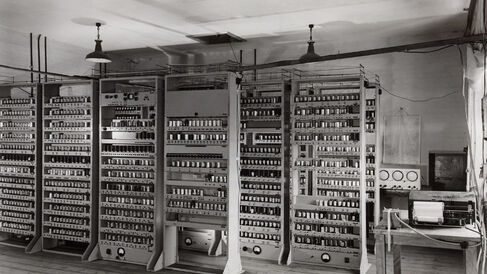The EDSAC and Computing in Cambridge

The years immediately following the Second World War saw the development of the first 'computers' as we know them today: digital, electronic, programmable calculating machines. Some of the most important early work in digital electronic computing was carried out in Cambridge during the post-war years. One of the first stored-program computers, the EDSAC, was developed by the University Mathematical Laboratory.
Computing coming of age
In the years between the two world wars, an explosion of research into electromechanical automation, along with a healthy dose of ingenuity, led to the development of electronic digital computers. In the early days, 'automatic' computers, such as Konrad Zuse's Z3 and Howard Aiken's Harvard Mark I, used electric relays and rotating wheels similar to the ones in adding machines.
Electronic computers made with vacuum tubes - which made them much faster - were the next development, and were a major strategic component of World War II. While the U.S.-made Electronic Numerical Integrator and Computer (ENIAC) was announced to much fanfare, the British government had actually built an earlier computer called Colossus. This had been kept hidden for decades, due to its origins in the wartime code-breaking work undertaken at Bletchley Park.
Early computers hardly resemble the machines we use today. They were mainly designed, like Babbage's Analytical Engine, to solve complex mathematical problems. Additionally, they had to be physically set up with a hard-wired program - switches and parts moved into place depending upon the calculation - and have instructions fed to them continually.
The major achievement that brought about the modern computer was the invention of the stored program: instructions that are stored in a computer's electronic memory. The first computer to have this feature was the University of Manchester's Small-Scale Experimental Machine, or "Baby." However, the first stored-program computer to go into regular use was Cambridge University's Electronic Delay Storage Automatic Calculator (EDSAC) in 1949.
In 1865 the Auzoux company introduced a new line of large-scale plant models. They complemented the new biology teaching programmes that were being introduced into universities and schools.
In the 1840s Dr. Auzoux began to produce models that illustrated embryo development. This was a very difficult area of study, especially for the early phases of development.
Computer power to share
Cambridge University established a Mathematical Laboratory in 1937. This was designed to both develop new computational techniques and provide a computing service for general staff and student use. In 1945 its sole full-time employee, Maurice Wilkes, assumed its directorship.
Wilkes was captivated when a friend visiting Cambridge in 1946 brought a document back from America called First Draft on a Report on the EDVAC, by the Manhattan Project mathematician John von Neumann. Wilkes was able to attend an important series of lectures on computers at the University of Pennsylvania later that year, and returned to the UK with a mission to design a practical computer based on von Neumann's principles to be used by the Cambridge community.
By focusing on reliable and proven design features rather than revolutionary architecture, the EDSAC was up and running by May 1949. The processing unit was made up of racks of vacuum tubes, and the memory consisted in mercury delay tubes, a technology with origins in radar.
Data was compressed into sound waves and sent into a medium, mercury, which slowed them down until the computer was ready to read them and translate the wave back into an electric signal. The EDSAC 2 (Image 1), which began operation a decade later, used magnetic memory similar to that still in use today along with programming and storage innovations to expand its memory and processing capacities.
One of the biggest innovations brought about by the EDSAC was the way it was used. In 1951 Wilkes and his colleagues, including David Wheeler, published one of the first programming texts, which explained how a computer program could be constructed using a relocatable subroutine.
Rather than coding out the instructions for repeated operations sequentially on a single strip of paper, Wilkes and his colleagues described a way of giving instructions to link operations (described as 'sub-routines') in what they called a load module. This increased efficiency, allowing computer time to be shared out to University staff and students. In 1950 EDSAC was the first computer to be used to solve a problem in the field of biology, when Wilkes and Wheeler collaborated with Ronald Fisher to solve a differential equation relating to gene frequencies.
Next steps
As ambitions for computing power increased, the Manchester University group behind Baby worked with the electrical engineering company Ferranti to build the Mark I (not to be confused with the Harvard Mark I), the first commercially available general purpose electronic computer. Following this collaboration, the team embarked on the Atlas project, which became the fastest supercomputer in the world at the start of its operation in 1962. Cambridge was in need of a faster computer, and agreed to purchase parts of an Atlas system to build a more affordable prototype for an Atlas 2, dubbed Titan.
The Cambridge team experimented with hardware to help the computer run more efficiently. Titan supervisor, developed to help different users share the machine, was one of the world's first time-sharing operating systems. The group also experimented with hardware, implementing secondary memory units known as caches to call up instructions more readily. The piece of memory shown here (Image 2) was called the 'slave store', and while it proved unreliable it helped pave the way for innovations in memory architecture.
Mikey McGovern
Mikey McGovern, 'The EDSAC and computing in Cambridge', Explore Whipple Collections, Whipple Museum of the History of Science, University of Cambridge.
